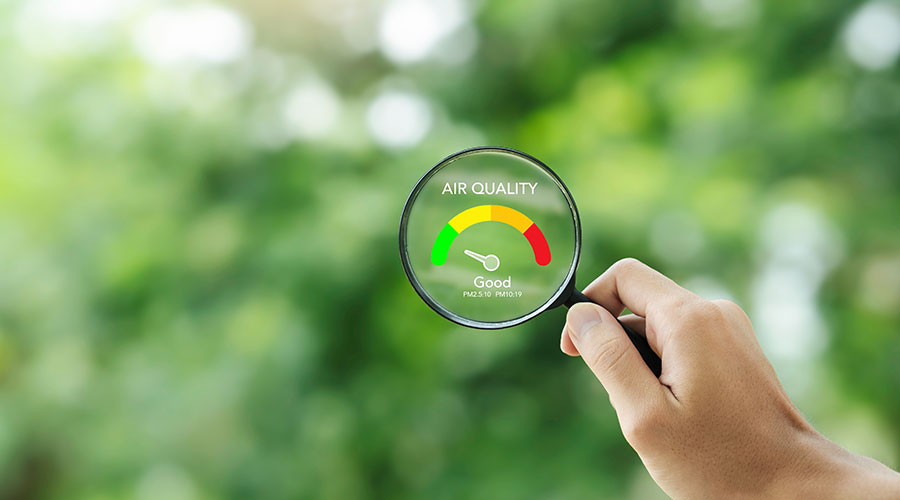Mold: Behind the Hype
The health risks of mold in buildings
make scientists nervous — but not because they think mold is toxic
Mold has emerged as the biggest, most costly and most controversial health issue to face building owners since concerns about asbestos prompted lawsuits, abatement programs and federal action two decades ago.
There is a $32 million judgement in a mold case in Texas, with estimates of millions more in settlements across the country. Insurance companies paid out $85 million for mold claims in 2001; in 2002, sky-high claims for $12 billion were filed in New York alone. Some experts say claim totals in dollars will dwarf amounts awarded in Superfund and asbestos cases combined.
States and the federal government are reacting. In the past two years, nine states have introduced or passed legislation dealing with mold. California has gone the farthest, passing its Toxic Mold Protection Act. The state is hoping, among other things, to do what no other state has done — set exposure limits. The Legislature has yet to fund a task force charged with enforcing the act. A similar bill was introduced into Congress last session, which also would require mold inspections of buildings.
Behind much of the concern is the fear that buildings are the breeding grounds of a particularly virulent strain of mold — “toxic mold” that threatens anyone exposed to it. But as lawyers and lawmakers sound the alarm about toxic mold, scientists and many health experts who have studied the subject strike a far more cautious note.
What little experts know now about mold lends little credence to the idea of killer molds in buildings, they say. Toxic molds produce poisons that can damage or kill cell tissue. There is no body of evidence that links molds typically found in buildings to a toxic effect in people.
But molds are not benign either and should be treated seriously. Molds are suspected of causing allergic reactions and respiratory illness that can be serious. An allergen is treated by the body as a foreign particle that the body wants to expel. And while the allergic effect is temporary, it can lead to long-term problems. What makes mold particularly troublesome is that scientists can’t say for sure who will have an allergic reaction and how serious it will be.
In Search of Answers
The fear of mold being a poisonous or toxic threat is understandable. After all, a small group of mold species can cause serious illness, although none of those species have been associated with buildings. For instance, there is a mold species that grows only on some agricultural crops and can cause cancer, but only if ingested. There is also evidence that a species of mold sometimes present in hay, straw and grain appears to cause a serious and possibly debilitating respiratory illness, hypersensitivity pneumonitis, more commonly referred to as Farmer’s Lung.
Particular attention has been focused on Stachybotrys chartarum. Stachybotrys, a slimy black mold, gained notoriety in 1994 when it was associated with a bleeding lung disease in children living in an apartment complex in Cleveland. Even though scientists later determined that the research was poorly done and scientists and other experts determined there was insufficient evidence to support the original conclusion, the stigma has stuck.
Researchers aren’t convinced that toxins in Stachybotrys are a threat because they don’t believe the toxins are likely to become airborne when the damp conditions that Stachybotrys is typically found in exists. If the mold dried out and the toxins did attach themselves to spores and became airborne, it is unlikely they would ever be at a concentration that would cause a serious illness in a commercial building, says John Sullivan, medical toxicologist and associate dean of the College of Medicine at the University of Arizona in Tucson. This is due to the life cycle of the mold and to air exchanges and filtration common in commercial buildings.
Because of this, Sullivan currently rejects the notion of toxic mold. Mycotoxins, poisons associated with fungi, have shown to have a detrimental effect in the laboratory, but there’s no evidence of it having this effect in the environment, Sullivan says.
Harriet Burge, a senior researcher at the Harvard School of Public Health in Boston, says there is no evidence supporting long-term health effects due to mycotoxins in indoor air, at least in doses commonly encountered indoors. The only long-term health outcomes have been cancer, and mycotoxins have not been blamed for cancer in environments other than such “occupational environments” as mines, grain mills and farms.
Sullivan, Burge and others say science just doesn’t know enough about how toxins affect humans yet, especially in the built environment.
“We know more than 300 species could produce mycotoxins,” says Carol Rao, a senior researcher in the Division of Respiratory Disease at the National Institute of Occupational Safety and Health. “But what we don’t know is how much they produce, what the effect of the environment is on production of toxins and under what circumstances they produce them.”
A Moving Target
If scientists are skeptical about toxic mold, that doesn’t mean mold is nothing to worry about. The real problem with mold is that it is suspected to cause numerous respiratory conditions, such as allergies, that could affect a significant percentage of the population. But even here, causal links are nonexistent.
Mold and mold spores are everywhere. Even in a sealed refrigerator, they can turn a lemon into a Chia pet. What scientists and medical experts know is that these ubiquitous mold spores may be hosts for allergens — chemicals that cause reactions, such as itching, wheezing, coughing and asthma — that affect people susceptible to those allergens. Allergic responses are not unique to mold, however. People can have similar reactions to dust mite feces, pollen, animal dander and many other particulates in the environment. So it is difficult to say which reactions can be blamed on mold.
One chronic allergic disease, asthma, has gotten close scrutiny lately because of dramatic increases of that condition in children. Scientists aren’t sure what’s behind the increase, but they are taking a look at a number of potential sources, including mold. They are especially concerned about cases involving prolonged exposure to mold.
“Asthma may be a permanent disease, especially if exposure to relevant allergens continues,” Harvard School of Public Health researcher Burge says. “On the other hand, if exposure ends, the asthma associated with that exposure also usually ends.”
Long-term exposure to mold may also make a person more sensitive to other agents, Rao says.
A number of extensive epidemiological, or population-based, studies do show a strong relationship between the presence of mold in a building and occupants with respiratory symptoms and diseases, usually allergic reactions.
According to Harriet Ammann, senior toxicologist in Washington State’s Department of Health in Olympia, these allergic reactions can range from mild and transitory to severe and chronic but will affect only atopic individuals — those individuals predisposed to expressing a reaction to a specific allergen.
That is the big problem in connecting mold allergies to a certain sector of the population. Doctors do not always understand who is allergic to what. This is especially true with mold, because species can easily form different subspecies in the environment. So it’s not always easy to tell who the atopic individuals are. A person may test negative for one mold species and yet react to it in the environment because of the form it takes, Ammann says. And it’s not just the form but the dose. An atopic individual might not react until receiving a significant enough dose of mold spores to cause a reaction.
There are lots of research questions and very little data, says Dr. Stephen Redd, chief, air pollution and respiratory health branch, National Center for Environmental Health, Centers for Disease Control and Prevention (CDC). For instance, can mold cause asthma in people not predisposed to having the disease? That is unknown.
“What causes these reactions in an individual, we don’t know,” Redd says. This is true even for Farmer’s Lung, where evidence of mold-disease link is fairly clear. The problem is that not everyone exposed to that mold will have the same symptoms, he says.
There are other unknowns as well. Redd says epidemiological studies show that exposure to high levels of mold causes illness in those with compromised immune systems and in atopic individuals. But exactly what “high levels” mean no one knows yet.
Rao agrees there’s a lot of data showing statistical associations and no good clinical association. Like most scientists, however, Rao says that a causative relationship cannot be ruled out simply because the evidence does not point to it now. “They just haven’t created the standards and methods necessary to test causation,” she says.
How Bad is Bad?
To the general public, this research is academic because experts agree mold should not be tolerated in the built environment. Is mold as serious as Legionella? It may not be fatal, but it is potentially a more widespread threat to health.
With Legionella, exposure has been documented to cause Legionnaire’s disease in certain people — namely people with compromised immune systems — and could be fatal. A healthy young adult exposed to Legionella, however, will not likely be affected. So there’s knowledge of cause and effect, but the impact is on a small percentage of the population.
That’s not exactly the situation with mold, Rao says.
“We know less about mold than Legionella in some ways, but exposure to mold could have broader implications for the population.”
How bad does mold have to get to be a problem?
“Nobody has clearly defined what level of mold would pose a significant health risk,” says David Bernstein, professor of medicine in the Allergy Division at the University of Cincinnati in Ohio. “And nobody has defined acceptable limits.”
“Basically, there is not much we really know specific to illness, exposure limits, and cause and effect,” Redd says. “If we had a good research base and evidence based on using a standardized method, it’s possible we could develop an exposure limit, for instance. We don’t have that yet.”
The U.S. Environmental Protection Agency, the American Industrial Hygiene Association and the CDC all concur with that. They say all molds should be treated as a potential health risk and be removed as quickly as possible. All three groups provide tips and guidelines for the safe removal of mold, whether by staff or an outside contractor.
The general consensus: It is better to be safe than sorry.
Lawyers, Insurance, Money
If the science is moving slowly, the courts are racing ahead. Litigation is being fueled by the confusion in the scientific world and the fact that mold is a visible indoor problem.
A rough estimate of the extent of mold litigation is 10,000 pending cases in the United States — a 300 percent increase in cases since 1999. California, Texas and Florida are particular hotbeds.
“Cases are filed in virtually every state on one aspect or another of mold claims,” says John Sweeney, attorney with Miles and Stockbridge in Baltimore. Most of the cases are being settled out of court, but of the litigated ones, a lot hinges on the admissibility of expert witnesses.
The problem is that, in certain jurisdictions, there is less scrutiny of expert witnesses before they are allowed to testify. Some courts will, for instance, allow a doctor to testify and base a diagnosis essentially on a process of elimination without any clinical evidence. Many of these jurisdictions can be found in California, Florida and Maryland.
In most courts — including most federal courts — there is a stricter guideline to follow on the admissibility of expert witnesses, says Susan Hickman, senior partner with the law firm of Hinshaw and Culbertson in Chicago.
The credibility of expert witnesses just begins to scratch the surface of the uncertainty on both the scientific side and legal side when it comes to litigating mold cases. Probably the most important thing building owners can do to avoid even getting involved in this legal miasma, Hickman says, is to prevent or carefully remove mold. The key to preventing claims is to have proactive and reactive plans in place. Above all, make sure moisture problems are taken care of immediately.
“Building owners should be prepared to recognize indoor air quality problems right away,” Hickman says.
Have policies and procedures in place, and if a mold issue or complaint is raised, keep lines of communication open at all times. Make sure the staff knows how to investigate a complaint, and make sure the staff or an outside contractor is capable of doing a proper remediation.
Minding one’s mold Ps and Qs is always a good idea because the trend for the future is more litigation. “The number of cases hasn’t peaked yet,” Hickman says.
This trend is bad news for building owners looking for insurance coverage against a lawsuit. Insurance companies are beginning to write exclusionary clauses for mold in their policies.
“The reinsurance business has started this drive for exclusionary clauses, and the full effect hasn’t hit the marketplace yet,” says David Dybdahl, senior consultant with the American Risk Management Resources Network in Middleton, Wis.
“This is going to affect not only building owners, but also architects, engineers, product manufacturers, contractors — anyone involved in the design, construction and maintenance of a building.
“This is not a Texas homeowner issue,” he says. “This is an indoor air quality issue. Even though the science is weak, plaintiffs are winning.”
This is important because regardless of what building owners know about mold, the perception of mold and the public tolerance toward it have changed.
“Building owners need to be sensitive to this change of opinion about mold,” Sweeney says. “If someone reports condensation and they suspect mold is forming, don’t tell them not to worry. Heading off a complaint is a lot easier than defending a complaint.”
Related Topics:











